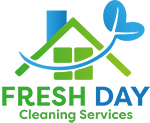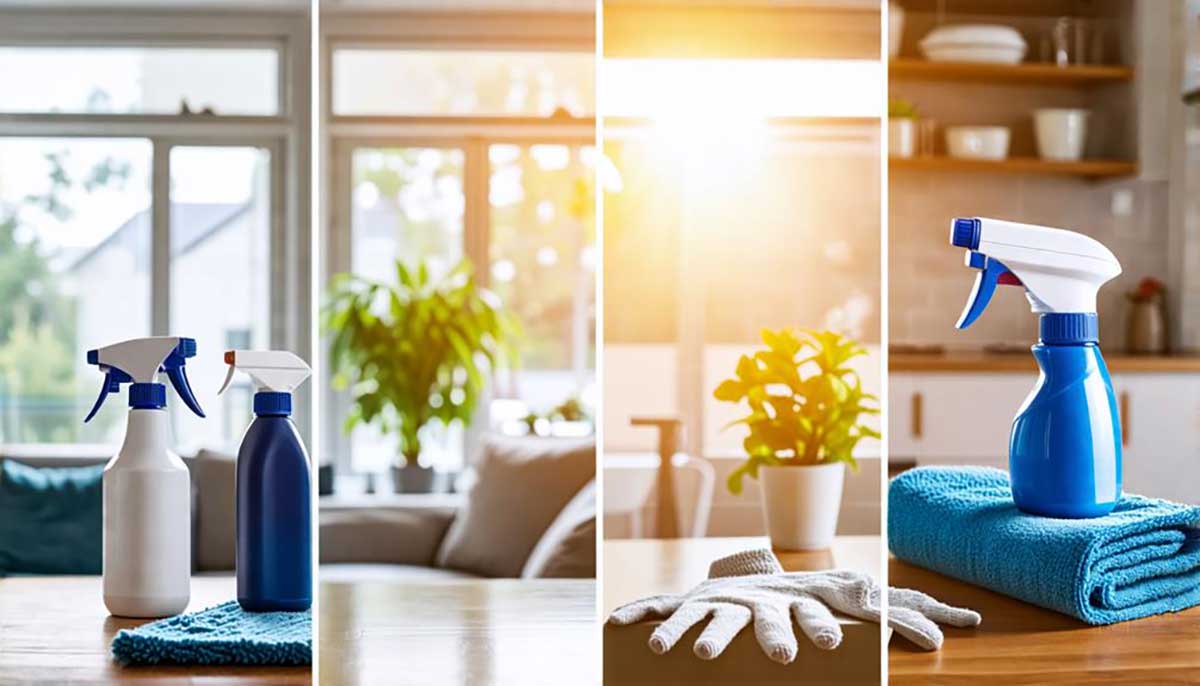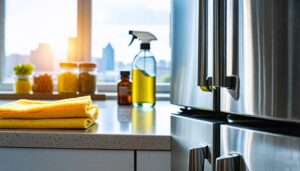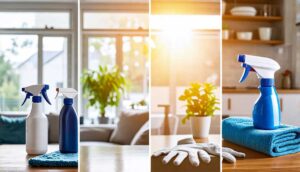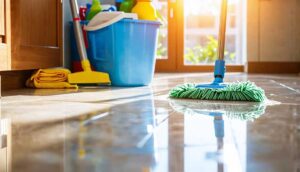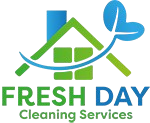Maintaining a healthy home in Columbia involves understanding the differences between cleaning, disinfecting, and sanitizing. Cleaning removes visible dirt and debris, preparing surfaces for further treatment. Sanitizing reduces germ levels, making it ideal for food-contact surfaces and high-touch areas. Disinfecting eliminates harmful pathogens, essential for high-risk areas or after illness exposure. The best approach combines all three methods: clean regularly, sanitize frequently touched surfaces daily, and disinfect high-risk areas or after known contamination. Choose EPA-registered products, follow manufacturer instructions, and prioritize safety when handling cleaning agents. A comprehensive home hygiene plan tailored to your household’s needs guarantees peak protection against germs and illness.
Understanding Germs in Your Home
Our homes, despite appearing clean to the naked eye, are teeming with microscopic organisms known as germs. These invisible microbes are ubiquitous, found on surfaces, in the air, and even on our skin. While some germs are beneficial, others can cause illnesses, making it vital to understand their presence and implement appropriate cleaning, disinfecting, and sanitizing strategies.
High-risk areas for germ transmission include frequently touched surfaces such as doorknobs, light switches, and countertops. Regular cleaning and sanitizing of these areas are essential to reduce the risk of spreading harmful microorganisms. It’s important to note that bacteria and viruses have different cleaning requirements. Sanitizers can often effectively reduce bacterial populations, but viruses may necessitate the use of stronger disinfectants for complete elimination.
Understanding the types of germs present in your home is key to selecting the most effective cleaning methods. By recognizing that many germs are microscopic and invisible, homeowners can appreciate the importance of consistent cleaning practices. This knowledge empowers individuals to maintain a hygienic environment through targeted cleaning, sanitizing, and disinfecting techniques, ultimately promoting a healthier living space for all occupants.
The Basics of Cleaning
Cleaning is the fundamental first step in maintaining a hygienic environment, focusing on the physical removal of dirt, grime, and impurities from surfaces. This process, which utilizes tools like mops, brooms, and sponges, significantly improves the appearance of your home and helps reduce the spread of germs. While cleaning alone does not kill germs, it prepares surfaces for effective sanitizing and disinfecting by eliminating organic material that can hinder the efficacy of germ-killing products.
Physical Dirt Removal
Physical dirt removal forms the foundation of any cleaning regimen. This essential step involves the use of tools such as mops, brooms, and sponges to eliminate visible dirt and impurities from surfaces throughout the home. The cleaning process is necessary for improving the overall appearance of living spaces and preparing surfaces for subsequent sanitizing or disinfecting treatments.
While cleaning does not kill germs, it significantly reduces their numbers by removing the dirt and organic matter that can harbor them. This reduction is critical, as visible dirt can interfere with the effectiveness of sanitizers and disinfectants. By thoroughly removing dirt, cleaning services guarantee that these more potent agents can work efficiently when applied.
Regular and meticulous cleaning practices are particularly important in high-traffic areas of the home, where dirt accumulation is more prevalent. Using appropriate cleaning products boosts the removal of dirt and contributes to maintaining a hygienic environment. The attention to detail required in the cleaning process is vital, as even small amounts of organic matter can obstruct the action of disinfectants, potentially compromising their germ-killing efficacy.
Essential First Step
At the core of maintaining a hygienic environment lies the fundamental process of cleaning. This essential first step involves the physical removal of dirt, grime, and impurities from surfaces using tools like mops, brooms, and sponges. While cleaning doesn’t kill germs, it significantly reduces their numbers by eliminating organic material that can harbor them. It’s important to note that effective cleaning prepares surfaces for subsequent sanitizing or disinfecting processes, enhancing their efficacy.
Cleaning products can improve dirt removal, but they must be used in conjunction with proper cleaning methods for best results. Regular, routine cleaning not only improves the overall appearance of your home but also plays an important role in reducing the potential spread of germs on surfaces.
Key points to remember about cleaning:
- It’s the initial step in maintaining a hygienic environment
- Focuses on physical removal of dirt and impurities
- Reduces germ numbers but doesn’t kill them
- Prepares surfaces for sanitizing or disinfecting
- Improves home appearance and reduces germ spread
Understanding the basics of cleaning is vital for maintaining a healthy home environment. By implementing effective cleaning practices, you create a foundation for more advanced hygiene measures, such as disinfecting, which target specific germs on surfaces.
Sanitizing: Reducing Germ Levels
Sanitizing effectively reduces germs on surfaces to safe levels, with EPA-registered sanitizers required to meet specific efficacy standards, including a 99.9% reduction in pathogenic bacteria. Common sanitizing methods include using chemical solutions, heat treatments, or UV light, with each method having specific applications and contact time requirements. Frequent sanitization is essential for high-touch surfaces in kitchens and bathrooms, while food contact surfaces demand more stringent sanitization protocols to achieve a 99.999% reduction in bacterial counts.
Sanitizer Effectiveness Standards
While cleaning and disinfecting are essential for maintaining hygiene, sanitizing plays an important role in reducing germ levels to acceptable standards. Sanitizer effectiveness is governed by strict standards to guarantee public health safety. Sanitizers and disinfectants must achieve a 99.9% reduction in bacterial counts on surfaces, with food contact sanitizers required to meet an even higher 5-log reduction (99.999%).
To be effective, sanitizers must:
- Be registered with the EPA, ensuring they meet specific germ-kill claims
- Follow detailed usage directions provided on the product label
- Achieve the required bacterial reduction within the specified contact time
- Be applied to pre-cleaned surfaces free of organic matter
- Maintain surface wetness for the designated period, often at least 30 seconds
The EPA registration number on sanitizer products confirms their compliance with effectiveness standards. It’s important to note that organic matter can interfere with sanitizer performance, emphasizing the importance of proper cleaning before application. Contact time is a significant factor in sanitizer effectiveness, as insufficient exposure may not achieve the desired germ reduction. By adhering to these standards, sanitizers effectively reduce pathogenic bacteria to levels deemed safe for public health.
Common Sanitizing Methods
The arsenal of sanitizing methods available to consumers and professionals alike includes a range of effective tools for reducing germ levels to acceptable standards. Common sanitizing methods encompass mild bleach solutions, alcohol-based wipes, and EPA-registered sanitizing sprays. While cleaning does not kill germs, these sanitizing techniques aim to reduce germ levels significantly, with food contact sanitizers achieving a 5-log reduction (99.999%) and non-food contact sanitizers typically targeting a 3-log reduction (99.9%).
| Method | Effectiveness | Application |
|---|---|---|
| Bleach Solution | High | Surfaces, Bathrooms |
| Alcohol Wipes | Moderate | Electronics, Handles |
| EPA Sprays | Varied | Multi-surface Use |
| Steam Cleaning | High | Fabrics, Floors |
| UV Light | High | Healthcare Facilities |
Healthcare facilities and high-traffic areas such as kitchens and bathrooms require more frequent sanitization to maintain hygiene and prevent germ spread. It’s essential to allow sanitizers to sit on surfaces for the specified contact time, which varies by product, to guarantee effectiveness. In homes with children, regular sanitizing is particularly important for items that come into contact with the mouth, like toys and utensils. By employing these methods consistently, individuals can significantly reduce the risk of germ transmission in their living spaces.
When to Sanitize
In environments where maintaining a safe level of cleanliness is essential, knowing when to sanitize becomes vital. Sanitizing is critical for reducing harmful germs on surfaces to safe levels recognized by public health standards, typically decreasing bacteria counts by 99.9%. High-traffic areas in your Columbia home, such as kitchens and bathrooms, require more frequent sanitizing to maintain hygiene and prevent illness.
When deciding when to sanitize, consider the following:
- After preparing raw food on countertops
- Before and after caring for someone who is sick
- After handling pet items or waste
- Following any spills or visible contamination
- On a regular schedule, especially in homes with children or immunocompromised individuals
Food contact surfaces, like utensils and countertops, should be sanitized with products designed for this purpose, ensuring they meet EPA registration for effectiveness. When using disinfectants, pay attention to the required contact time specified on the product label to effectively reduce germ levels. Regular sanitization is vital in minimizing the risk of spreading infectious diseases, particularly in households with vulnerable individuals. By implementing a consistent sanitizing routine, you can maintain a healthier living environment in your Columbia home.
Disinfecting: Eliminating Harmful Pathogens
Eliminating harmful pathogens through disinfection plays an essential role in maintaining a healthy environment. Disinfecting products are designed to kill germs and prevent the spread of illnesses, including COVID-19, by completely eradicating pathogens on surfaces. Unlike cleaning, which only removes impurities from a surface, disinfecting guarantees a 100% elimination of microbes.
To be effective, disinfectants must be EPA-registered, assuring their safety and efficacy against a wide range of pathogens. Proper application is vital: surfaces should be pre-cleaned to remove organic matter that may interfere with the disinfectant’s performance. Additionally, disinfectants require specific contact times, during which surfaces must remain visibly wet to assure complete pathogen elimination.
Regular disinfection is particularly important in high-risk areas such as kitchens and bathrooms, as well as after illness recovery in households. This practice significantly reduces infection risks. It’s important to note that while cleaning vs disinfecting serve different purposes, both are essential components of a comprehensive hygiene routine. By understanding and implementing proper disinfection techniques, individuals can create safer, healthier environments in their homes and workplaces.
When to Clean vs. Sanitize
Understanding when to clean versus sanitize is key to maintaining a hygienic environment. Cleaning is the essential first step in any sanitization process, as it removes dirt and impurities from surfaces. This preparatory action allows for more effective sanitizing or disinfecting afterwards. Sanitizing is recommended for surfaces that come into contact with food or are frequently touched, reducing bacteria to safe levels based on public health standards.
For routine maintenance in settings like child care facilities and schools, regular sanitization is advised. However, disinfecting becomes essential after known exposure to illnesses such as COVID-19 or in high-risk areas. To guarantee effective germ reduction, it’s critical to understand the specific usage instructions on product labels.
When deciding whether to clean or sanitize, consider the following:
- Clean all surfaces regularly to remove visible dirt and debris
- Sanitize food-contact surfaces and frequently touched areas
- Disinfect high-risk areas or after illness recovery
- Follow product label instructions for proper application
- Adjust cleaning and sanitizing frequency based on usage and risk level
Choosing the Right Disinfectants
Selecting the appropriate disinfectants is vital for maintaining a hygienic environment in your Columbia home. When choosing disinfectants, prioritize EPA registered products, as this certification guarantees their effectiveness against specific pathogens, including COVID-19. These products have undergone rigorous testing to confirm their ability to eliminate bacteria and viruses.
Pay close attention to the active ingredients listed on the product label, such as bleach or hydrogen peroxide, which are known for their broad-spectrum antimicrobial properties. Understanding the difference between cleaning vs disinfecting is essential; while cleaning removes visible dirt, disinfecting kills germs on surfaces.
Consider the contact time required for each disinfectant, as this factor significantly impacts its efficacy. Products typically need to remain wet on surfaces for several minutes to effectively eliminate pathogens. Select disinfectants that are suitable for the specific surfaces in your home, as some formulations are designed for particular materials or high-touch areas.
Lastly, consider eco-friendly options to minimize environmental impact. Some traditional disinfectants can harm aquatic ecosystems, so opting for environmentally responsible products can help protect both your home and the surrounding environment.
Safe Cleaning Practices
To maintain a safe and healthy home environment, implementing proper cleaning practices is vital. When using cleaning products and disinfectants, it’s important to prioritize safety for both yourself and your family members. Always store cleaning agents in their original containers and keep them out of children’s reach to prevent accidental ingestion or exposure to harmful chemicals.
Before using any cleaning products, carefully read and follow the product labels for proper usage instructions, including contact time, to guarantee effectiveness and safety during cleaning. When handling disinfectants, use personal protective equipment (PPE) such as gloves and eye protection to minimize exposure risks.
To guarantee safe cleaning practices in your Columbia home, follow these guidelines:
- Avoid mixing cleaning products unless specified safe on labels
- Use appropriate PPE when handling disinfectants
- Store cleaning agents in original containers and out of reach of children
- Follow product labels for proper usage instructions and contact time
- Regularly consult updated guidelines for safe cleaning practices
High-Touch Areas Needing Attention
While implementing safe cleaning practices is important, identifying and addressing high-touch areas in your home is equally essential for maintaining a hygienic environment. High-touch areas, such as doorknobs, light switches, and countertops, require daily attention to remove dirt and reduce the spread of germs. These surfaces are breeding grounds for pathogens and demand frequent sanitization, particularly in households with children or elderly individuals.
The Centers for Disease Control (CDC) recommends disinfecting surfaces in high-touch areas at least once daily, especially during flu season or when a household member is ill. To effectively eliminate pathogens, disinfectants must be applied to clean surfaces and left wet for the specified contact time. It’s vital to note that cleaning protocols for these areas should be regularly monitored and maintained to significantly decrease the risk of infections within the home.
Creating a Home Hygiene Plan
Establishing a comprehensive home hygiene plan is essential for maintaining a clean and healthy living environment. To create an effective plan, focus on regularly cleaning high-touch surfaces like doorknobs, light switches, and countertops to remove dirt and impurities that can harbor germs. Incorporate sanitizing protocols using EPA-registered products on food contact surfaces, particularly in kitchens and dining areas, to reduce pathogenic bacteria to safe levels.
Schedule disinfecting sessions after illness recovery or in high-risk areas, guaranteeing surfaces are pre-cleaned for maximum efficacy against harmful pathogens. When applying disinfectants, use proper personal protective equipment (PPE) to avoid exposure to hazardous chemicals that may cause irritation or respiratory issues.
Key components of a home hygiene plan:
- Regular cleaning of high-touch surfaces
- Sanitizing food contact areas
- Disinfecting after illness or in high-risk zones
- Proper use of PPE when handling chemicals
- Ongoing review and update of cleaning practices
Stay informed about current CDC and EPA guidelines to guarantee your cleaning, sanitizing, and disinfecting practices remain effective and safe for your household. By implementing a thorough hygiene plan, you can significantly reduce the risk of germ transmission and maintain a healthier home environment.
Frequently Asked Questions
Which Is Better Sanitizing or Disinfecting?
The choice between sanitizing and disinfecting depends on specific needs. Sanitizing benefits include quick application and effectiveness for everyday use, reducing germs to safe levels. Disinfecting methods are more thorough, eliminating a broader range of pathogens. Effectiveness comparison shows disinfecting as superior for high-risk areas or during illness outbreaks. Consider surface types when choosing, as some materials may be sensitive to harsh disinfectants. Health implications favor disinfecting in medical settings, while sanitizing suffices for routine home cleaning.
What Comes First, Sanitize or Disinfect?
When considering sanitizing techniques and disinfecting products for home cleaning and health safety, it’s important to note that neither sanitizing nor disinfecting comes first. Cleaning always precedes both processes. After cleaning, the order of sanitizing or disinfecting depends on the specific needs and surface types. Generally, sanitizing is sufficient for routine maintenance, while disinfecting is necessary for high-risk areas or after illness. Always follow product instructions for ideal effectiveness and safety in your home cleaning regimen.
What Is the Correct Order for Cleaning and Sanitizing?
The correct order for cleaning and sanitizing involves a two-step process. First, implement proper cleaning techniques using effective products to remove visible dirt and debris from various surface types. This prepares the area for sanitization. Second, apply an EPA-registered sanitizer to reduce bacteria to safe levels. Follow frequency guidelines based on surface usage and exposure. Adhering to this order guarantees peak health benefits by thoroughly removing contaminants before lowering germ counts, creating a safer environment for occupants.
What Is Better, Bleach or Disinfectant?
The choice between bleach and disinfectant depends on specific cleaning needs and surface types. Bleach offers broad-spectrum effectiveness against pathogens but requires careful handling due to bleach safety concerns. Disinfectants often provide quicker results and may be safer for certain surfaces. Both can effectively eliminate germs when used correctly. Consider the health impact of each method, as well as the specific cleaning requirements of different areas. Ultimately, the best choice depends on the situation and the user’s comfort with various cleaning methods.
